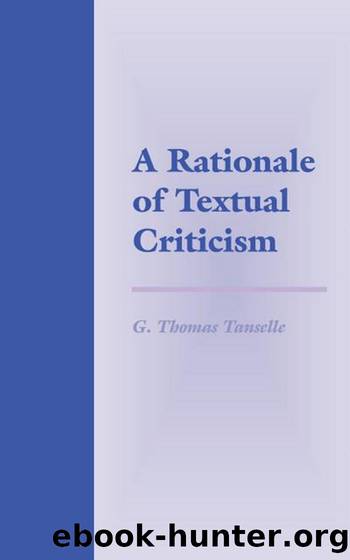A Rationale of Textual Criticism by Tanselle G. Thomas;

Author:Tanselle, G. Thomas;
Language: eng
Format: epub
Publisher: University of Pennsylvania Press
THREE
Reconstructing the Texts of Works
The woman walking along the Key West strand, in Wallace Stevensâs poem, transmutes the sea into her song; but the two are different, we are told, âEven if what she sang was what she heard, / Since what she sang was uttered word by word.â In verbal communication, everything depends on the procession of words, one by one, in sequence. When a word, or the sequence, is altered, the meaning can be expected to change. The text the woman sang may not have been the text she intendedâbut not because it seemed to her (as no doubt it would have seemed) an inadequate expression of the complexity of her upwelling emotions. The execution of a statement never exhausts the potentiality of the ideas underlying it. Even so, certain words were intended, but through one slip of the tongue or another some of them may have come out differently in the uttering. The assembled listeners were able in any case to recognize that her song was a made reality, a created world: they understood, as they listened, that âthere never was a world for her / Except the one she sang and, singing, made.â We are not told whether any of the listeners mentally corrected some of the words they heard, in the process of forming their individual interpretations of the singerâs world. But what they heard did have an effect on them, altering their perceptions of their own worlds; for as they turned toward the town, the lights in the fishing boats âMastered the night and portioned out the sea, / Fixing emblazoned zones and fiery poles, / Arranging, deepening, enchanting night.â The exemplary world of her creation gave direction to the ârage for orderâ in each of them, helping them to find undreamed-of patterns in the chaos around them and enhancing the vibrancy of their participation in it. Textual criticism was a part of this processâeven if Stevens does not say soâbecause the listeners had to decide whether the words presented to them were the ones that, taking everything into account, they should respond to. Each of the listeners had been presented with a text and was engaged in finding in it a work. The presented text was a historical fact; the text of the work was an imaginative construction based on it, and possibly different for each of them. But it was the work that affected them, for they were trying to understand what was being said, even if the uttered words sometimes subverted it.
Every verbal text, whether spoken or written down, is an attempt to convey a work. The preservation of the documents containing verbal texts, like the preservation of other artifacts, is a vital cultural activity. But the act of preserving such documents, unlike that of preserving paintings, for example, does not preserve works but only evidences of works. If, as readers, we are interested in the verbal works that their producers intended, we must constantly entertain the possibility of altering the texts we have inherited.
Download
This site does not store any files on its server. We only index and link to content provided by other sites. Please contact the content providers to delete copyright contents if any and email us, we'll remove relevant links or contents immediately.
Anxious People by Fredrik Backman(2387)
The Last Thing He Told Me by Laura Dave(2106)
The Soulmate Equation by Christina Lauren(1792)
Romancing Mr. Bridgerton (Bridgerton 04) by Julia Quinn(1439)
Not a Happy Family by Shari Lapena(1418)
The Switch by Beth O'Leary(1289)
Slough House by Mick Herron(1273)
Life's Too Short by Abby Jimenez(1266)
Solutions and Other Problems by Allie Brosh(1223)
Kiss My Cupcake by Helena Hunting(1198)
Mordew by Alex Pheby(1183)
This Time Next Year by Sophie Cousens(1114)
A Rogue of One's Own by Evie Dunmore(1039)
No One Is Talking About This by Patricia Lockwood(990)
The Mary Shelley Club by Goldy Moldavsky(975)
Playing Nice by JP Delaney(966)
Squeeze Me: A Novel by Carl Hiaasen(935)
Roadside Picnic by Arkadi & Boris Strugatsky(924)
Quinoterapia by Quino(915)
